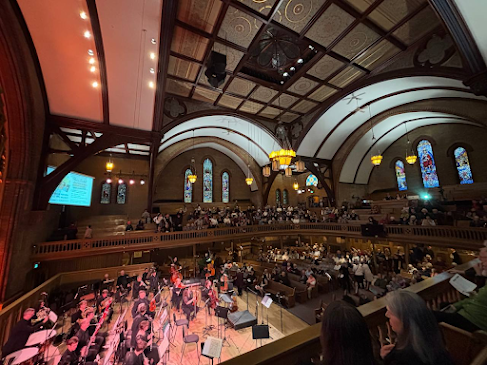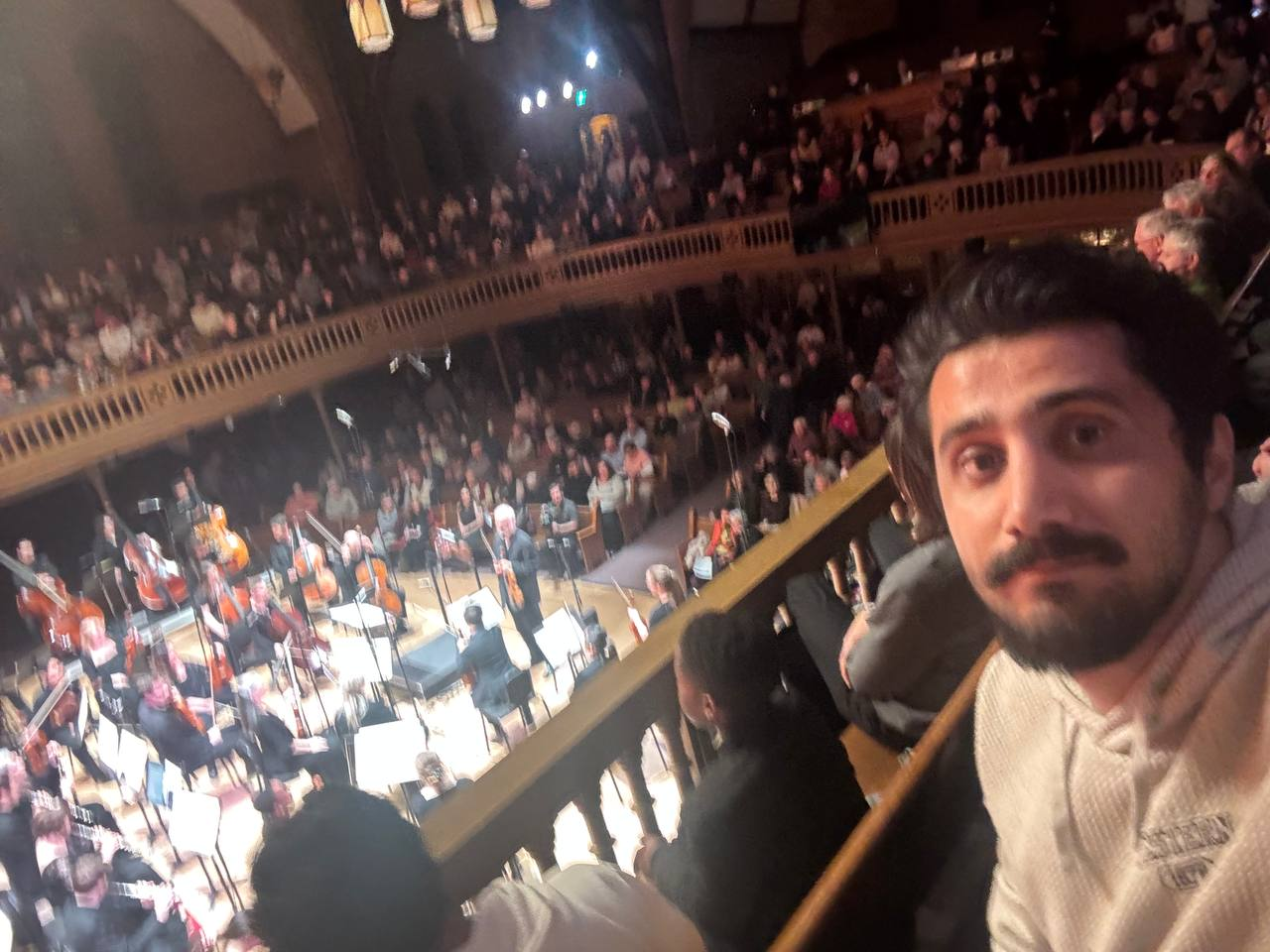The Winds of History Blow in Ontario: On Sibelius’s Second Symphony
The Winds of History Blow in Ontario: On Sibelius’s Second Symphony
A
Philosophical Impression of Symphony No. 2 (1902) by Jean Sibelius, the Finnish
Composer
Farid Saberi
Some Preliminary Notes:
April 5th, a sunny and pleasant spring day in London, I got lucky, a friend of mine offered me to go to this classical music performance which (being a busy graduate student) I had no idea was going on. I put on my spring coat and got the bus there. There were two works planned to be performed. Beethoven’s Violin Concerto and Sibelius' Second Symphony. The following are my philosophical impressions and the notes that I was making while listening to the second Sibelius' work. I wrote the notes in Farsi and here I have translated them into English. The only reason I went to this concert was Beethoven (my ultimate all-time favorite composer). I had no knowledge of Sibelius and his work. In the end, I ended up being captured by his second symphony and writing about it. Since the beginning of the performance, I was struck by the presence of a strong Beethovenian spirit in this work and this has been reflected in my notes. It was to my pleasant surprise that when I later read some articles about this work, I realized that music critics and historians have also highlighted this feature of the work since its release in 1902 (Not bad at all for an amateur listener and learner of classical music like me). Let's learn a bit more about this work and then we will turn to my impressions notes. All the photos and videos in this post were recorded on my personal phone.
Sibelius is known as the national composer of Finland. He is credited with aiding the Finnish national spirit in the face of Tsarist Russia’s attempts to Russify Finland. This symphony in particular is often referred to as the “Symphony of Independence.” The conductor of its first performance in Helsinki, Robert Kajanus, wrote about it: "It is a broken-hearted protest against all injustices that threaten our sunlight and the scent of our flowers." Others have praised Symphony No. 2 for its direction and Beethovenian passion (link).
A Philosophical Impression of Symphony No. 2 (1902) by Jean Sibelius
The notes of this symphony hold an unbelievable power. It’s hard to believe they can so completely seize the atmosphere and cleanse it of all distractions. The rising and falling of a note, a chord, and their relentless, inescapable return make me feel as though I am once again living in the presence of history. They treat the worldly sufferings, the tears and smiles of humans—these earth-dwelling animals—as something celestial, with the sacred obsession of saints.
This music stages the fervor of a people rushing toward liberation, flourishing, and resistance. They feel night and despair in their bones, in all its darkness. And they celebrate the birth of light like blood surging through their veins. It is an uncompromising invitation to take mortal human life seriously. It has a special resonance for the age of the end of history. The human and popular spirit is summoned once more from the wasteland of history’s end and neoliberal triumphalism. And once again, it is called upon to respond to the fundamental questions of human existence—the questions of rebellion against oppression and exploitation. With every movement and strike, the Symphony asks:
How
can one not respond?
How
can one leave such questions unanswered?
How
can one evade giving a resolute answer?
How can one not fight?
Every movement and note of Sibelius’s Second Symphony asks these questions insistently. Human justice and freedom, as collective matters, are only achieved through the grandeur of fighting and not surrendering. Faith in the curability of human life’s pains is the steadfast conviction that makes this post-Beethovenian music of Sibelius possible.
How can one strip away the passion, excitement, and
struggle of battle from this symphony and still call it music? A secular and
revolutionary concept of life flows throughout this entire post-Beethovenian
work. Life—as struggle, as growth, and transformation—still finds a place in the
hidden corners of the once-grand but now abandoned house of classical music.
This concept of human life—as something dynamic, historical, and collective,
growing dialectically from within contradictions—lies at the deep foundation of post-Beethovenian
classical music.
This vision of life was born after the French Revolution, in the republican dreams of the wretched and the workers of Paris welcomed and celebrated by Beethoven. And after the wreck and despair of the world wars, with the rise of the individualistic American dream and the proclaimed “end of history,” it was buried. On this springtime evening in London, Ontario, its tune sounds strange. As the conductor mentioned before the performance, Canada needs the nationalistic spirit of this piece in the face of Trump’s America, just as Finland once needed it against Tsarist Russia.
The sound of this music remains alive and thunderous. It’s as though a passionate political speech appears before us, as though it was written just yesterday. It cries out. It roars. With the majestic, march-like grandeur of its percussion and brass, it reminds its audience again and again that what is at stake is a fierce struggle. Each time, it rouses the people with endurance. It calls them to the public square the public sphere.
It asks: How can the square be empty—as long as humans
suffer, and are still able to feel that suffering, to see it and share it?
This music calls us to come together, to name our pain and our dreams.
But how, and in what way, can one recognize the languid,
suffocating, and desolate days of our time from the summit-like grandeur of
this music? The Beethovenian spirit of this work still carries the traces of
Beethoven’s revolution against the sacred, churchly music of Bach, and the
composed, dignified, aristocratic music of Mozart. The sacred is rendered
earthly, historical, and republican. Balance and dignity are broken—and only
through the mud and clay of struggles, through conflict and storm, does the horizon
finally open, luminous and harmonious.
In this work, Sibelius appears as Beethoven’s best student at the turn of the twentieth century, at the close of the nineteenth. At a time when the individualistic and sentimental romanticism of post-Beethoven composers had already buried the republican fervor of his music, Sibelius’s Second Symphony was a Finnish return to Beethoven.
The
sublime in this work appears in a new form. Theology and God have receded from
it, but the longing for the sublime has not been abandoned—it still sings, and
moves forward with great strides, toward untying the knots of life, the knots
of the symphony, and toward a people free of wounds, tyranny, and exploitation.
A free people.
It
speaks to people whose spirits have returned to their weary bodies. It is an
invitation to see and to feel across a vast width and depth—to experience what
are called the silent tragedies of life, the ones we often lack the courage and
bravery to face in our everyday living. It calls for living life and its
emotions all the way through, to the very end.
This
music stages the victory of the human spirit. It is a music of
rebellion—against the thick, deadening force of silenced experiences and pains.
A rebellion against the paralyzing silence of tyranny. Against buttoned-up
coats and backs turned to the winds that blow through life and are meant to
fill it with abundance and bloom.
This
music is a call to live on the summits—where we are directly exposed to the sun, wild winds, to torrential rains. In Symphony No. 2, we hear the voice of
nature. The voice of nature has its own language. Human voices are alive. The
voices of history and of the times are alive. The voices of the people and
their revolutions are alive, and they have all come to the field together.
Listen—listen.
We are here. Life is not a solo of a single lonely, sorrowful note. There is
contradiction, and there is joy. There is fighting—with belief, with faith,
with companionship and compassion. Life is seeing—and having faith in seeing
rightly. Faith in walking, and in the worth of walking.
How
magnificently it cries out that never, not ever, is it true that without the
divine or the transcendent, humanity and its life are meaningless. It is a
resounding cry that human pains—though invisible on the cosmic scale—are not
meaningless. They are full of meaning and possess a non-divine grandeur, a
human grandeur.
Post-Beethovenian music was the bold discovery of something sublime—a historical grandeur of mortal human beings and what they live through. How beautiful that this music still wants us to believe that we are not alone and that history is not over. Who else but this music weeps and shouts for humanity and its tragedies?
A post Script:
Why it is too late for Canadian Nationalism?
The conductor at London Symphonia, Tania Miller made some observations before the performance of the symphony. She draws a parallel between the spirit of Finish's resistance against Tzarist Russia and the (apparently) increasing need for a Canadian resistance against a Trumpist US. She mentioned how Canada now needs a spirit of nationalism. As a socialist who has been against the US Imperialist intervention for the longest time, I found these remarks pretty self-congratulatory and even ridiculous. Canadian ruling class, its capitalists and investors, and its political elite have been greedy assistants and lap dog of American Imperialism. Critics like Chomsky have been calling upon Canada to be independent in its foreign policy and also its economic policy. Conservatives and Liberals have been too busy and greedy to even notice these calls for being Canadian, independent, and somewhat nationalistic. They went all in in American Imperialist adventures just to get a seat at the big guy's table. With NAFTA and other trade and economic policies, Canadian politicians bought into the Washington Consensus and Neoliberal agenda harder than some of their American counterparts. The result was to create two separate worlds. A first-world Canada for the ruling class and higher middle class and a third-world Canada for the Canadian working poor. The profitability of first-world Canada was saved at the expense of undermining Canadian working-class life conditions and quality to the degree of a deprived and exploited third-world country population. Deregulations and privatization, budget cuts to the public sector, and tax cuts for the rich have put the population of the country at the mercy and benefit from their unprecedently stronger ruling class and their unregulated power. Neoliberalism, as Chomsky has famously said, is not applying the universal logic of free competition and free market, but rather deregulation and privatization in the service of the capitalist profit rates. In practice, neoliberalism is rendering a country, its population, and public policy hostage to the unlimited power of a capitalist class.
Canadian ruling class and political elite had no limit in their mindless assistantship of the Master (the US). The general approach was "no question asked" and there was no talk of the patriotic value of independent Canadian viewpoints and policies. It was dedicated mindlessly to the Master's plan. And it kept at it until the Master pushed them away. Had it not pushed them away, they would have still been loyal assistant to the Master. If the Master grows kind again, the Canadian ruling class will not hesitate to jump into the Master's bed again. Canadian leftist and independent intellectuals (if there are any left), should resist the temptation of glorifying this rising tide of Canadian patriotism promoted by the liberal class. They should show how this is just mobilizing third-world Canada to defend first-world Canada against its beloved Master. If there is going to be any meaningful mobilization, it should not be that of Canada against the US but that of third-world Canada against their first-world rulers.





Comments
Post a Comment